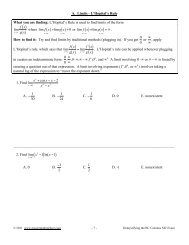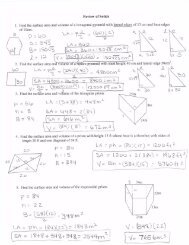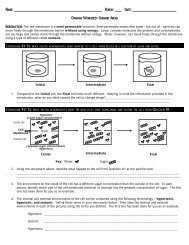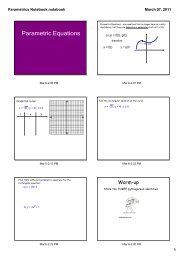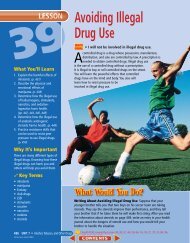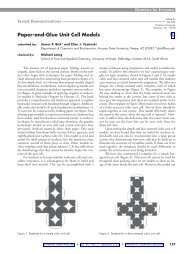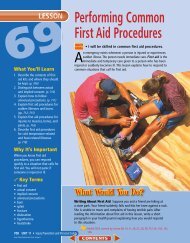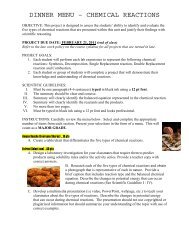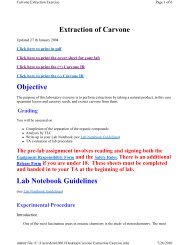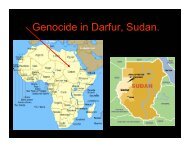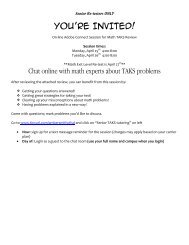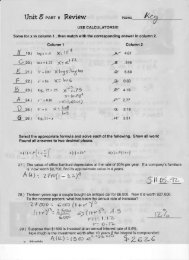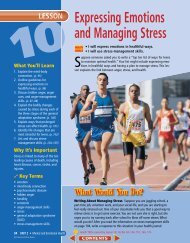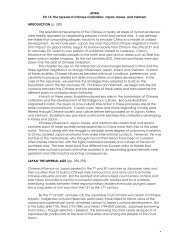WORLD GEOGRAPHY FALL FINAL EXAM REVIEW Unit 1: Tools of ...
WORLD GEOGRAPHY FALL FINAL EXAM REVIEW Unit 1: Tools of ...
WORLD GEOGRAPHY FALL FINAL EXAM REVIEW Unit 1: Tools of ...
You also want an ePaper? Increase the reach of your titles
YUMPU automatically turns print PDFs into web optimized ePapers that Google loves.
Name: __________________________________________________<br />
<strong>Unit</strong> 1: <strong>Tools</strong> <strong>of</strong> Geography<br />
1. Define Geography: (pg5)<br />
2 Label the following: (notes)<br />
<strong>WORLD</strong> <strong>GEOGRAPHY</strong> <strong>FALL</strong> <strong>FINAL</strong> <strong>EXAM</strong> <strong>REVIEW</strong><br />
T - __________, O - ___________, D- ____________, A-__________, L - ___________, S-____________<br />
3. What is the best and most accurate map <strong>of</strong> the Earth? (pg10)<br />
4. What is the difference between Absolute Location and Relative Location? (pg 6)<br />
5. Latitude measures _________________ & _____________________ <strong>of</strong> the ____________________. (pg 6)<br />
6. Longitude measures _______________ & _____________________ <strong>of</strong> the ____________________. (pg 6)<br />
7. What is the latitude and longitude <strong>of</strong> Houston, TX? (map <strong>of</strong> Texas)<br />
<strong>Unit</strong> 2: Physical Geography<br />
8. What internal forces in the Earth create mountains, earthquakes, and tsunamis? (pg 37)<br />
11. Define Erosion: (pg 43)<br />
12. What types <strong>of</strong> external forces can cause erosion? (pg 43-44)<br />
9. What two things do climograph show <strong>of</strong> a location’s<br />
physical geography?<br />
10. According to the climograph <strong>of</strong> Austin, TX, which<br />
month has the highest temperatures and the lowest<br />
precipitation?<br />
13. What type <strong>of</strong> climate and vegetation would the country <strong>of</strong> Ecuador have? (think <strong>of</strong> the latitude) (pg 60)<br />
14. What type <strong>of</strong> climate and vegetation would a city located in the Great Basin have? (pg 60)
<strong>Unit</strong> 3: Human Geography<br />
15. If a country’s life expectancy is 80 years, would the country most likely be developed or less developed? (pg 79)<br />
16. Define Per Capita GDP: (pg 94)<br />
17. Define Infant Mortality Rate: (pg 79)<br />
18. Define the Columbian Exchange: (pg 136)<br />
19. What geographical concept would the Columbian Exchange be an example <strong>of</strong>? (pg 136 & notes)<br />
20. Define each Theme <strong>of</strong> Geography: (pgs 5-9)<br />
Theme <strong>of</strong><br />
Geography<br />
Location<br />
Region<br />
Movement<br />
Human<br />
Environment<br />
Interaction (HEI)<br />
Place<br />
21. Draw the shape <strong>of</strong> each population pyramid: (pg 79 & notes)<br />
Definition<br />
Positive/ Rapid Growth Steady/Slow Growth Negative/Decreasing Growth
22. Match each quote with the correct economic sector (pg 92)<br />
Primary Sector<br />
Secondary Sector<br />
Tertiary Sector<br />
Quaternary Sector<br />
<strong>Unit</strong> 4: Anglo America<br />
23. Complete the table below: (pg 81)<br />
DEFINITION<br />
LIST 3<br />
<strong>EXAM</strong>PLES<br />
PUSH FACTORS PULL FACTORS<br />
24. What does the Bill <strong>of</strong> Rights protect for American citizens? (notes)<br />
25. Define Democracy: (pg 83)<br />
I work in the Apple Factory. We<br />
make the computer chips that go<br />
into I-pods, I-pads, and Iphones.<br />
I work at the Apple stores<br />
in the mall. I help people<br />
that have issues with their<br />
I-pods, I-pads, and MAC<br />
computers.<br />
I work in the mines that retrieve<br />
the metal that is used to make<br />
the computer chips for Apple<br />
Products. I have also found other<br />
natural materials like gold and<br />
diamonds<br />
I work at a university that does<br />
research for Apple. I do tests and<br />
studies on faster internet services<br />
and help create new technology<br />
that will benefit the Apple<br />
customers.
26. What is a Break <strong>of</strong> Bulk Center? (notes)<br />
27. Where are most cities located? (pg 88)<br />
28. Roads, sewer systems, power lines, skyscrapers, schools, and hospitals are all examples <strong>of</strong> what? (pg 94)<br />
29. Which US region is the known as the Breadbasket <strong>of</strong> America? (pg 147)<br />
30. Which US region do people think students ride their horses to school? (pg 148)<br />
31. Which US region can you visit many megalopolis? (pgs 145-146)<br />
32. Which US city is a functional region for the entertainment industry? (Hint: many celebrities live there) (pgs 148-149)<br />
33. Which US city is a functional region for upholding democracy in America? (pg 147)<br />
34. Which Canadian providence can you find the French culture? (pg 161)<br />
35. What are the two main languages in Canada? (pg 161)<br />
36. According to the map, how do ships travel throughout<br />
the Great Lakes and the St. Lawrence Seaway System?<br />
37. What two bodies <strong>of</strong> water does the St. Lawrence<br />
Seaway connect? How will that help the national<br />
economy <strong>of</strong> the <strong>Unit</strong>ed States?<br />
38. The beginning <strong>of</strong> the US Constitution states: “We The People….” Which principle <strong>of</strong> democracy states that people rule the<br />
government? (notes)<br />
Circle the answer:<br />
39. Which term is the same concept as a CITY? (pgs 88 & 137)<br />
RURAL AREAS URBAN AREAS OVERPOPULATION REPRESENTATIVE DEMOCRACY
<strong>Unit</strong> 5: Europe<br />
40. What landform is the European continent considered? (pg 273)<br />
41. What is the purpose for building polders in the Netherlands? (pgs 282-283)<br />
42. Why did European nations colonize other parts <strong>of</strong> the world? What were they looking for to help increase industry? (pg 304)<br />
43. What two countries does the Channel Tunnel connect? (notes)<br />
44. The spread <strong>of</strong> the Black Death in medieval Europe would be an example <strong>of</strong>: (pg 294-295)<br />
45. List three effects <strong>of</strong> industrial pollution: (pgs 284-285 & 323-325)<br />
46. Balkanization is an example <strong>of</strong>: (pgs 319-321)<br />
47. Who are the two groups <strong>of</strong> people fighting in Northern Ireland? (notes)<br />
48. Complete the diagram: (notes)<br />
FREEDOM: _________________<br />
(Political system)<br />
Berlin<br />
Wall<br />
during<br />
Cold<br />
War<br />
49. What is the purpose <strong>of</strong> the European Union? (pgs 326-327)<br />
GOVERNMENT CONTROL: ______________<br />
(Political System)<br />
50. List 3 requirements for countries to have to become a member <strong>of</strong> the European Union: (notes & pgs 326-327)
<strong>Unit</strong> 6: Russia and the Republics<br />
51. How many time zones does Russia cross? (pg 345)<br />
52. Chernozem: (pg 345)<br />
53. What is the physical feature that is considered the dividing line between Europe and Asia? (pg 346)<br />
54. What is happening to the Aral Sea? What are some <strong>of</strong> the effects? (think physical and human) (pg 353)<br />
55. What caused the explosion at Chernobyl? (pg 368-369)<br />
56. Communism: (pg 83)<br />
57. What region is having ethnic disputes and wants to become an independent country? (pgs 385-387)<br />
58. Siberia: (pg 349)<br />
59. What was the transportation innovation that was built to help move people and goods across Russia? (pg 355)<br />
60. What was the name <strong>of</strong> the nation formed by the Communist Party in 1922? (pg 363)<br />
World Map pgs A2 & A 3<br />
Label/ draw the<br />
following items:<br />
North America<br />
South America<br />
Africa<br />
Australia<br />
Asia<br />
Antarctica<br />
Atlantic Ocean<br />
Pacific Ocean<br />
Indian Ocean<br />
Arctic Ocean<br />
South Ocean<br />
Equator<br />
Prime Meridian<br />
Tropic <strong>of</strong> Cancer<br />
Tropic <strong>of</strong> Capricorn<br />
Artic Circle
Physical Geography<br />
Atlantic Ocean<br />
Pacific Ocean<br />
Gulf <strong>of</strong> Mexico<br />
Great Lakes<br />
Mississippi River<br />
Rio Grande<br />
St. Lawrence River<br />
Rocky Mountains<br />
Appalachian Mountains<br />
Great Plains<br />
Great Basin<br />
Anglo America Map pgs 103 & 105<br />
Label/Draw the items for the Anglo America Map.<br />
Political Geography<br />
Washington D.C., USA<br />
Ottawa, Canada<br />
Houston, TX, USA<br />
Los Angles, CA, USA<br />
New York City, NY, USA<br />
Chicago, IL, USA<br />
Vancouver, Canada<br />
Toronto, Canada<br />
British Columbia Province, Canada<br />
Quebec Province, Canada
Physical Geography<br />
Atlantic Ocean<br />
Mediterranean Sea<br />
North Sea<br />
Danube River<br />
Alps Mountains<br />
Pyrenees Mountains<br />
Ural Mountains<br />
North European Plain<br />
Iberian Peninsula<br />
Italian Peninsula<br />
Balkan Peninsula<br />
Scandinavian Peninsula<br />
British Isles<br />
Europe Map pgs 263 &265<br />
Label/Draw the items for the Europe Map<br />
Political Geography<br />
Rome, Italy<br />
London, England<br />
Berlin, Germany<br />
Madrid, Spain<br />
Amsterdam, Netherlands<br />
Brussels, Belgium<br />
Dublin, Ireland<br />
Paris, France<br />
Athens, Greece<br />
Serbia<br />
Bosnia
Physical Geography<br />
Pacific Ocean<br />
Artic Ocean<br />
Black Sea<br />
Caspian Sea<br />
Aral Sea<br />
Ural Mountains<br />
Siberia<br />
Russian Far East<br />
North European Plain<br />
Russia and the Republics Map pg 336-337 & 338 – 339<br />
Label/Draw the items for the Russia and Republics Map<br />
Political Geography<br />
Moscow, Russia<br />
St. Petersburg, Russia<br />
Chernobyl, Belarus<br />
Kiev, Ukraine<br />
Kazakhstan<br />
STUDY TIPS:<br />
1. DON’T WAIT! Start Studying Little Bits At A Time. You will remember more!<br />
2. Eat a good breakfast the day <strong>of</strong> the final.<br />
3. Use all resources to study: school wires websites, tutorials, text book, class notes, etc.<br />
4. Learn the definitions and also how to use them in examples.<br />
5. Learn the places on the maps. Practice drawing your own maps from memory and label the items on<br />
your own maps from memory.<br />
6. Ask questions BEFORE the exam. If you don’t understand something, don’t be afraid to ask!<br />
GOOD LUCK STUDYING AND ON YOUR <strong>FINAL</strong> <strong>EXAM</strong>S!!!!



